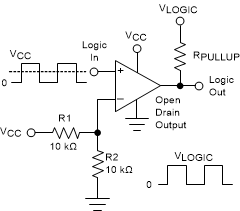SNOSDA3F June 2020 – March 2023 TLV9020 , TLV9021 , TLV9022 , TLV9024 , TLV9030 , TLV9031 , TLV9032 , TLV9034
PRODMIX
- 1 Features
- 2 Applications
- 3 Description
- 4 Revision History
- 5 Pin Configuration and Functions
-
6 Specifications
- 6.1 Absolute Maximum Ratings
- 6.2 ESD Ratings
- 6.3 Recommended Operating Conditions
- Thermal Information, TLV90x0,TLV90x1
- 6.4 Thermal Information, TLV90x2
- 6.5 Thermal Information, TLV90x4
- 6.6 Electrical Characteristics, TLV90x0,TLV90x1
- 6.7 Switching Characteristics, TLV90x0,TLV90x1
- 6.8 Electrical Characteristics, TLV90x2
- 6.9 Switching Characteristics, TLV90x2
- 6.10 Electrical Characteristics, TLV90x4
- 6.11 Switching Characteristics, TLV90x4
- 6.12 Typical Characteristics
- 7 Detailed Description
-
8 Application and Implementation
- 8.1 Application Information
- 8.2 Typical Applications
- 8.3 Power Supply Recommendations
- 9 Layout
- 10Device and Documentation Support
- 11Mechanical, Packaging, and Orderable Information
Package Options
Mechanical Data (Package|Pins)
Thermal pad, mechanical data (Package|Pins)
Orderable Information
8.2.5 Logic Level Shifter
The output of the TLV902x is the uncommitted drain of the output transistor. Many open-drain outputs can be tied together to provide an output OR'ing function if desired.
 Figure 8-14 Universal Logic Level Shifter
Figure 8-14 Universal Logic Level ShifterThe two 10 kΩ resistors bias the input to half of the input logic supply level to set the threshold in the mid-point of the input logic levels. Only one shared output pull-up resistor is needed and may be connected to any pull-up voltage between 0 V and 5.5 V. The pullup voltage must match the driven logic input "high" level.